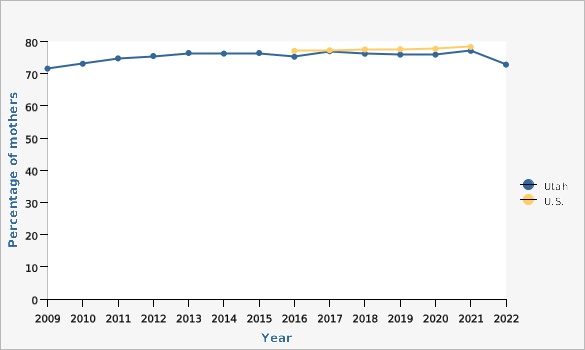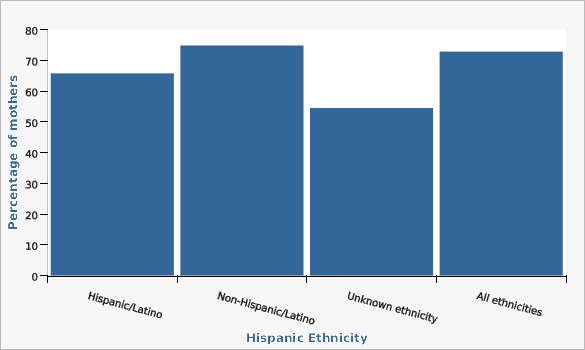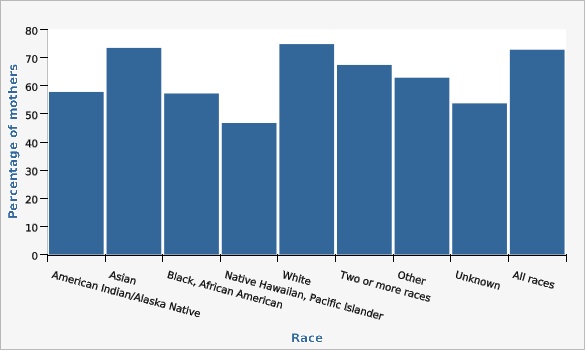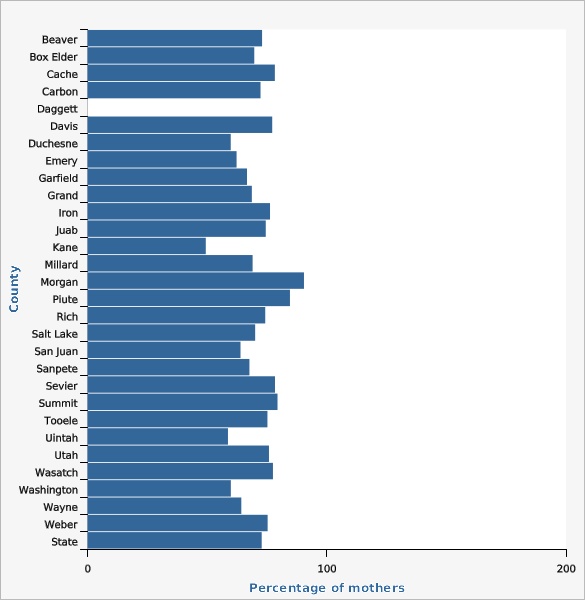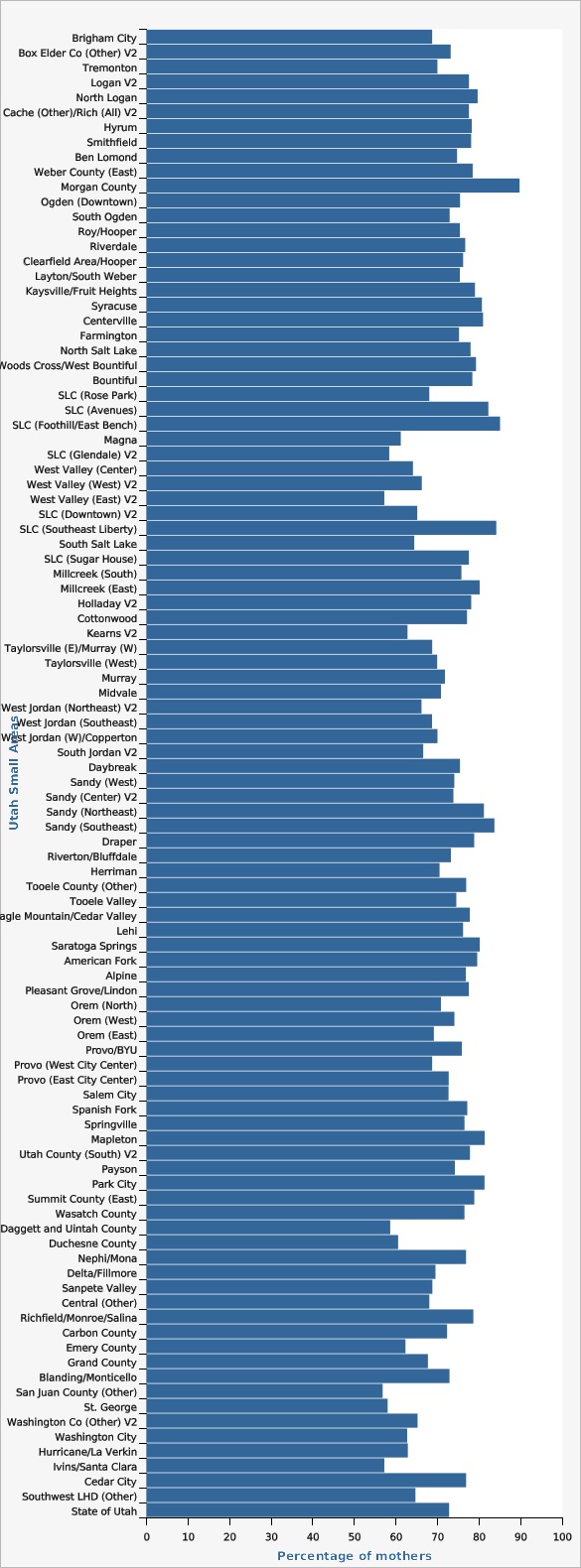Complete Health Indicator Report of Prenatal Care
Definition
Number of infants born to pregnant women receiving prenatal care in the first trimester as a percentage of the total number of live births.Numerator
Number of infants born to pregnant women receiving prenatal care in the first trimester.Denominator
Number of live births.Data Interpretation Issues
Utah prenatal care reporting is not comparable to the U.S. between the 1989 and 2003 revisions of the birth certificate due to wording and format changes. Utah adopted the 2003 U.S. revision to the birth certificate in 2009. The U.S. began reporting U.S. rates of first trimester prenatal care in 2016.Why Is This Important?
Women who receive early and consistent prenatal care (PNC) enhance their likelihood of giving birth to a healthy child. Health care providers recommend that women begin prenatal care in the first trimester of their pregnancy.Other Objectives
Healthy People 2030 has an objective of Increasing the proportion of pregnant women who receive early and adequate prenatal care--MICH-08 with a baseline of 76.4% (2018) and a goal of 80.5%.How Are We Doing?
The percentage of women entering prenatal care in the first trimester of pregnancy increased to 77.1% in 2021, the highest reported since 2009, then decreased to 72.8% in 2022.How Do We Compare With the U.S.?
The National Center for Health Statistics began reporting U.S. rates of first trimester prenatal care in 2016. Among women giving birth in the U.S. in 2021, 78.3% began prenatal care in the first trimester of pregnancy, compared to 77.1% in 2021 in Utah.What Is Being Done?
The Utah Department of Health and Human Services Baby Your Baby Program sponsors a statewide media campaign and provides information and referral services to pregnant women in Utah. MotherToBaby (formerly Pregnancy Risk Line) is a phone service available to pregnant women, the public, and health care providers who have questions about possible effects of medications, chemicals, or infectious agents on a developing baby or breastfed infant. MotherToBaby can be reached by both phone calls or text messaging. The Pregnancy Risk Assessment Monitoring System (PRAMS) collects and analyzes data to identify characteristics of Utah women and their utilization of prenatal care. The Maternal and Infant Health Program will utilize these data to target interventions in those populations identified as having poor first trimester entry.Available Services
'''Baby Your Baby:''' 1-800-826-9662[[br]] [http://www.babyyourbaby.org][[br]] A public resource to answer pregnancy related questions and and locate services. '''MotherToBaby:''' Phone - 1-800-822-2229[[br]] Text - 1-855-999-3525[[br]] Email - expertinfo@mothertobaby.org[[br]] A service to answer questions about what's safe during pregnancy and breastfeeding.[[br]] [[br]] Social media for MotherToBaby include: *Facebook: [http://www.facebook.com/MotherToBaby] *Twitter: @MotherToBaby *Pinterest: [http://www.pinterest.com/MotherToBaby]Health Program Information
Early entry into prenatal care for women with limited financial resources is facilitated by the Division of Integrated Healthcare's Presumptive Eligibility for Prenatal Medicaid Program - also known as the Baby Your Baby Program. Applicants are screened via a brief application and those meeting the program's eligibility requirements are able to receive a medical card that will provide temporary coverage in order to allow them to begin prenatal care from any willing Medicaid provider in Utah. During the time the woman has temporary coverage, she completes the Medicaid Application. The Baby Your Baby Program acts as a bridge into Prenatal Medicaid and allows women to start their prenatal care in a timely manner.Related Indicators
Relevant Population Characteristics
Data show the following population subgroups are less likely to enter prenatal care in their first trimester: *Mothers younger than 20, especially teens *Non-White Race *Hispanic ethnicity *Low educational attainment (high school or less) *Unmarried women *Women who have had three or more previous birthsRelated Relevant Population Characteristics Indicators:
Health Care System Factors
Data show the following health care system factors contribute to being less likely to enter prenatal care in the first trimester: *Lack of health insurance *Availability of family planning services (if a pregnancy is planned, a woman is more likely to seek early and adequate prenatal care)Related Health Care System Factors Indicators:
Risk Factors
Data show the following risk factors contribute to being less likely to enter prenatal care in the first trimester: *Tobacco use during pregnancyRelated Risk Factors Indicators:
Health Status Outcomes
Increased costs associated with premature births, low birth weight births, and maternal and infant mortality and morbidity are related to a lack of prenatal visits.Related Health Status Outcomes Indicators:
Graphical Data Views
| Utah vs. U.S. | Year | Percentage of mothers | Lower Limit | Upper Limit | ||
|---|---|---|---|---|---|---|
Record Count: 20 | ||||||
| Utah | 2009 | 71.6% | 71.2% | 72.0% | ||
| Utah | 2010 | 73.1% | 72.7% | 73.5% | ||
| Utah | 2011 | 74.8% | 74.4% | 75.1% | ||
| Utah | 2012 | 75.5% | 75.1% | 75.9% | ||
| Utah | 2013 | 76.4% | 76.0% | 76.8% | ||
| Utah | 2014 | 76.2% | 75.9% | 76.6% | ||
| Utah | 2015 | 76.4% | 76.0% | 76.8% | ||
| Utah | 2016 | 75.3% | 74.9% | 75.6% | ||
| Utah | 2017 | 77.0% | 76.6% | 77.4% | ||
| Utah | 2018 | 76.2% | 75.8% | 76.6% | ||
| Utah | 2019 | 75.9% | 75.5% | 76.3% | ||
| Utah | 2020 | 75.9% | 75.5% | 76.3% | ||
| Utah | 2021 | 77.1% | 76.7% | 77.4% | ||
| Utah | 2022 | 72.8% | 72.4% | 73.2% | ||
| U.S. | 2016 | 77.1% | ||||
| U.S. | 2017 | 77.3% | ||||
| U.S. | 2018 | 77.5% | ||||
| U.S. | 2019 | 77.6% | ||||
| U.S. | 2020 | 77.7% | ||||
| U.S. | 2021 | 78.3% | ||||
Data Notes
Percentage of mothers of live born infants where prenatal care was reported to have been received in the first trimester (births where prenatal care was unreported were counted in the denominator). [[br]] [[br]] Utah began use of the 2003 birth certificate version in 2009. Prenatal care reporting is not comparable to earlier years due to wording and format changes. The National Center for Health Statistics began reporting U.S. rates of first trimester prenatal care in 2016.Data Sources
- Utah Birth Certificate Database, Office of Vital Records and Statistics, Utah Department of Health and Human Services
- National Center for Health Statistics
| Hispanic Ethnicity | Percentage of mothers | Lower Limit | Upper Limit | |||
|---|---|---|---|---|---|---|
Record Count: 4 | ||||||
| Hispanic/Latino | 65.7% | 64.8% | 66.7% | |||
| Non-Hispanic/Latino | 74.8% | 74.4% | 75.2% | |||
| Unknown ethnicity | 54.5% | 50.2% | 58.8% | |||
| All ethnicities | 72.8% | 72.4% | 73.2% | |||
Data Notes
Percentage of mothers of live born infants where prenatal care was reported to have been received in the first trimester (births where prenatal care was unreported were counted in the denominator).Data Source
Utah Birth Certificate Database, Office of Vital Records and Statistics, Utah Department of Health and Human Services| Race | Percentage of mothers | Lower Limit | Upper Limit | |||
|---|---|---|---|---|---|---|
Record Count: 9 | ||||||
| American Indian/Alaska Native | 57.8% | 52.9% | 62.7% | |||
| Asian | 73.5% | 70.9% | 75.9% | |||
| Black, African American | 57.2% | 53.5% | 61.0% | |||
| Native Hawaiian, Pacific Islander | 46.8% | 43.2% | 50.4% | |||
| White | 74.8% | 74.4% | 75.2% | |||
| Two or more races | 67.4% | 65.2% | 69.6% | |||
| Other | 62.9% | 60.9% | 64.8% | |||
| Unknown | 53.7% | 49.2% | 58.3% | |||
| All races | 72.8% | 72.4% | 73.2% | |||
Data Notes
Percentage of mothers of live born infants where prenatal care was reported to have been received in the first trimester (births where prenatal care was unreported were counted in the denominator).Data Source
Utah Birth Certificate Database, Office of Vital Records and Statistics, Utah Department of Health and Human Services| Local Health District | Percentage of mothers | Lower Limit | Upper Limit | |||
|---|---|---|---|---|---|---|
Record Count: 14 | ||||||
| Bear River | 75.8% | 74.2% | 77.4% | |||
| Central | 72.2% | 69.4% | 74.8% | |||
| Davis County | 77.2% | 76.0% | 78.4% | |||
| Salt Lake County | 70.1% | 69.3% | 70.8% | |||
| San Juan | 64.0% | 56.8% | 71.1% | |||
| Southeast | 68.6% | 64.4% | 72.9% | |||
| Southwest | 64.2% | 62.7% | 65.8% | |||
| Summit | 79.4% | 75.2% | 83.2% | |||
| Tooele | 75.2% | 72.5% | 77.7% | |||
| TriCounty | 59.2% | 55.7% | 62.6% | |||
| Utah County | 75.8% | 75.1% | 76.6% | |||
| Wasatch | 77.5% | 73.0% | 81.6% | |||
| Weber-Morgan | 75.8% | 74.4% | 77.2% | |||
| State of Utah | 72.8% | 72.4% | 73.2% | |||
Data Notes
Percentage of mothers of live born infants where prenatal care was reported to have been received in the first trimester (births where prenatal care was unreported were counted in the denominator). [[br]] [[br]] Note: Local health district represents district of mother's residence.Data Source
Utah Birth Certificate Database, Office of Vital Records and Statistics, Utah Department of Health and Human Services| County | Percentage of mothers | Lower Limit | Upper Limit | Note | ||
|---|---|---|---|---|---|---|
Record Count: 30 | ||||||
| Beaver | 73.0% | 63.8% | 81.0% | |||
| Box Elder | 69.7% | 66.6% | 72.8% | |||
| Cache | 78.3% | 76.5% | 80.0% | |||
| Carbon | 72.3% | 66.0% | 78.1% | |||
| Daggett | ** | ** | ||||
| Davis | 77.2% | 76.0% | 78.4% | |||
| Duchesne | 59.9% | 54.3% | 65.4% | |||
| Emery | 62.3% | 54.0% | 70.6% | |||
| Garfield | 66.7% | 53.3% | 80.0% | |||
| Grand | 68.7% | 59.6% | 77.8% | |||
| Iron | 76.3% | 73.3% | 79.1% | |||
| Juab | 74.5% | 68.0% | 80.3% | |||
| Kane | 49.4% | 39.0% | 59.8% | |||
| Millard | 69.0% | 62.1% | 75.9% | |||
| Morgan | 90.5% | 84.0% | 95.2% | |||
| Piute | 84.6% | 60.6% | 102.9% | * | ||
| Rich | 74.3% | 57.8% | 88.2% | |||
| Salt Lake | 70.1% | 69.3% | 70.8% | |||
| San Juan | 64.0% | 56.8% | 71.1% | |||
| Sanpete | 67.7% | 62.9% | 72.5% | |||
| Sevier | 78.4% | 73.1% | 83.0% | |||
| Summit | 79.4% | 75.2% | 83.2% | |||
| Tooele | 75.2% | 72.5% | 77.7% | |||
| Uintah | 58.7% | 54.2% | 63.2% | |||
| Utah | 75.8% | 75.1% | 76.6% | |||
| Wasatch | 77.5% | 73.0% | 81.6% | |||
| Washington | 59.9% | 57.9% | 61.9% | |||
| Wayne | 64.3% | 46.5% | 82.0% | |||
| Weber | 75.3% | 73.8% | 76.7% | |||
| State | 72.8% | 72.4% | 73.2% | |||
Data Notes
Percentage of mothers of live born infants where prenatal care was reported to have been received in the first trimester (births where prenatal care was unreported were counted in the denominator). Note: County represents county of mother's residence. * Use caution in interpreting rates for estimates with an asterisk. These estimates have a coefficient of variation >30% and are therefore deemed unreliable by Utah Department of Health and Human Services standards. ** The estimates for Daggett county have been suppressed because 1) the relative standard error is greater than 50% or 2) the observed number of events is very small and not appropriate for publication.Data Source
Utah Birth Certificate Database, Office of Vital Records and Statistics, Utah Department of Health and Human Services| Utah Small Areas | Percentage of mothers | Lower Limit | Upper Limit | |||
|---|---|---|---|---|---|---|
Record Count: 100 | ||||||
| Brigham City | 68.7% | 63.7% | 73.8% | |||
| Box Elder Co (Other) V2 | 73.2% | 66.1% | 79.5% | |||
| Tremonton | 70.0% | 64.7% | 74.9% | |||
| Logan V2 | 77.6% | 74.7% | 80.3% | |||
| North Logan | 79.7% | 75.5% | 83.4% | |||
| Cache (Other)/Rich (All) V2 | 77.6% | 72.7% | 81.9% | |||
| Hyrum | 78.3% | 72.0% | 83.7% | |||
| Smithfield | 78.1% | 72.6% | 82.9% | |||
| Ben Lomond | 74.7% | 71.8% | 77.5% | |||
| Weber County (East) | 78.5% | 74.1% | 82.4% | |||
| Morgan County | 89.8% | 83.2% | 94.6% | |||
| Ogden (Downtown) | 75.4% | 72.0% | 78.6% | |||
| South Ogden | 72.9% | 68.9% | 76.7% | |||
| Roy/Hooper | 75.4% | 71.8% | 78.8% | |||
| Riverdale | 76.7% | 72.0% | 80.9% | |||
| Clearfield Area/Hooper | 76.2% | 73.5% | 78.7% | |||
| Layton/South Weber | 75.4% | 72.8% | 77.9% | |||
| Kaysville/Fruit Heights | 79.0% | 74.5% | 83.0% | |||
| Syracuse | 80.7% | 76.5% | 84.4% | |||
| Centerville | 81.0% | 74.9% | 86.1% | |||
| Farmington | 75.2% | 69.5% | 80.3% | |||
| North Salt Lake | 78.0% | 73.2% | 82.2% | |||
| Woods Cross/West Bountiful | 79.3% | 73.3% | 84.4% | |||
| Bountiful | 78.4% | 74.8% | 81.6% | |||
| SLC (Rose Park) | 68.0% | 63.5% | 72.5% | |||
| SLC (Avenues) | 82.2% | 75.6% | 87.7% | |||
| SLC (Foothill/East Bench) | 85.1% | 79.7% | 89.5% | |||
| Magna | 61.2% | 56.8% | 65.6% | |||
| SLC (Glendale) V2 | 58.4% | 53.2% | 63.6% | |||
| West Valley (Center) | 64.1% | 60.6% | 67.6% | |||
| West Valley (West) V2 | 66.2% | 61.6% | 70.9% | |||
| West Valley (East) V2 | 57.2% | 53.8% | 60.7% | |||
| SLC (Downtown) V2 | 65.1% | 59.6% | 70.7% | |||
| SLC (Southeast Liberty) | 84.2% | 78.4% | 88.9% | |||
| South Salt Lake | 64.4% | 59.1% | 69.7% | |||
| SLC (Sugar House) | 77.6% | 73.0% | 81.7% | |||
| Millcreek (South) | 75.8% | 69.7% | 81.2% | |||
| Millcreek (East) | 80.2% | 74.7% | 84.9% | |||
| Holladay V2 | 78.1% | 72.1% | 83.4% | |||
| Cottonwood | 77.1% | 72.8% | 81.0% | |||
| Kearns V2 | 62.8% | 59.0% | 66.6% | |||
| Taylorsville (E)/Murray (W) | 68.7% | 64.8% | 72.7% | |||
| Taylorsville (West) | 69.9% | 65.8% | 74.1% | |||
| Murray | 71.8% | 67.6% | 75.8% | |||
| Midvale | 70.9% | 66.9% | 74.5% | |||
| West Jordan (Northeast) V2 | 66.2% | 61.5% | 70.8% | |||
| West Jordan (Southeast) | 68.7% | 64.7% | 72.7% | |||
| West Jordan (W)/Copperton | 70.0% | 66.5% | 73.3% | |||
| South Jordan V2 | 66.6% | 61.9% | 71.3% | |||
| Daybreak | 75.4% | 71.5% | 79.0% | |||
| Sandy (West) | 74.1% | 69.3% | 78.4% | |||
| Sandy (Center) V2 | 73.8% | 68.5% | 78.7% | |||
| Sandy (Northeast) | 81.2% | 74.8% | 86.5% | |||
| Sandy (Southeast) | 83.7% | 78.2% | 88.3% | |||
| Draper | 78.8% | 75.1% | 82.2% | |||
| Riverton/Bluffdale | 73.2% | 69.9% | 76.4% | |||
| Herriman | 70.5% | 67.8% | 73.1% | |||
| Tooele County (Other) | 76.9% | 71.3% | 81.9% | |||
| Tooele Valley | 74.5% | 71.4% | 77.5% | |||
| Eagle Mountain/Cedar Valley | 77.8% | 75.4% | 80.0% | |||
| Lehi | 76.2% | 74.0% | 78.2% | |||
| Saratoga Springs | 80.2% | 77.4% | 82.7% | |||
| American Fork | 79.6% | 76.7% | 82.2% | |||
| Alpine | 76.8% | 67.2% | 85.0% | |||
| Pleasant Grove/Lindon | 77.6% | 74.6% | 80.3% | |||
| Orem (North) | 70.8% | 67.0% | 74.4% | |||
| Orem (West) | 74.1% | 71.4% | 76.6% | |||
| Orem (East) | 69.1% | 64.2% | 74.1% | |||
| Provo/BYU | 75.9% | 72.1% | 79.3% | |||
| Provo (West City Center) | 68.7% | 65.1% | 72.4% | |||
| Provo (East City Center) | 72.7% | 68.6% | 76.5% | |||
| Salem City | 72.7% | 64.8% | 79.6% | |||
| Spanish Fork | 77.2% | 74.1% | 80.0% | |||
| Springville | 76.5% | 73.1% | 79.7% | |||
| Mapleton | 81.4% | 74.8% | 86.8% | |||
| Utah County (South) V2 | 77.8% | 73.6% | 81.6% | |||
| Payson | 74.2% | 70.1% | 78.0% | |||
| Park City | 81.3% | 75.6% | 86.2% | |||
| Summit County (East) | 78.9% | 72.4% | 84.4% | |||
| Wasatch County | 76.5% | 71.9% | 80.6% | |||
| Daggett and Uintah County | 58.6% | 54.2% | 63.1% | |||
| Duchesne County | 60.5% | 55.0% | 66.1% | |||
| Nephi/Mona | 76.9% | 69.9% | 82.9% | |||
| Delta/Fillmore | 69.5% | 61.6% | 77.5% | |||
| Sanpete Valley | 68.8% | 62.9% | 74.7% | |||
| Central (Other) | 68.0% | 62.9% | 73.2% | |||
| Richfield/Monroe/Salina | 78.6% | 72.6% | 83.8% | |||
| Carbon County | 72.3% | 66.0% | 78.1% | |||
| Emery County | 62.3% | 54.0% | 70.6% | |||
| Grand County | 67.7% | 58.4% | 77.1% | |||
| Blanding/Monticello | 72.9% | 63.6% | 81.1% | |||
| San Juan County (Other) | 56.8% | 42.2% | 71.4% | |||
| St. George | 58.0% | 55.3% | 60.7% | |||
| Washington Co (Other) V2 | 65.2% | 57.3% | 73.2% | |||
| Washington City | 62.7% | 58.0% | 67.5% | |||
| Hurricane/La Verkin | 62.9% | 57.6% | 68.1% | |||
| Ivins/Santa Clara | 57.2% | 50.0% | 64.4% | |||
| Cedar City | 76.9% | 73.8% | 79.8% | |||
| Southwest LHD (Other) | 64.7% | 59.5% | 69.9% | |||
| State of Utah | 72.8% | 72.4% | 73.2% | |||
Data Notes
Percentage of mothers of live born infants where prenatal care was reported to have been received in the first trimester (births where prenatal care was unreported were counted in the denominator). [[br]] [[br]] Note: Utah Small Area represents area of mother's residence. [[br]] [[br]] A description of the Utah Small Areas may be found on IBIS at the following URL: [https://ibis.health.utah.gov/resource/Guidelines.html].Data Source
Utah Birth Certificate Database, Office of Vital Records and Statistics, Utah Department of Health and Human ServicesMore Resources and Links
Evidence-based community health improvement ideas and interventions may be found at the following sites:- Centers for Disease Control and Prevention (CDC) WONDER Database, a system for disseminating public health data and information.
- United States Census Bureau data dashboard.
- Utah healthy Places Index, evidence-based and peer-reviewed tool, supports efforts to prioritize equitable community investments, develop critical programs and policies across the state, and much more.
- County Health Rankings
- Kaiser Family Foundation's StateHealthFacts.org
- Medical literature can be queried at PubMed library.
Page Content Updated On 03/28/2024,
Published on 04/02/2024

